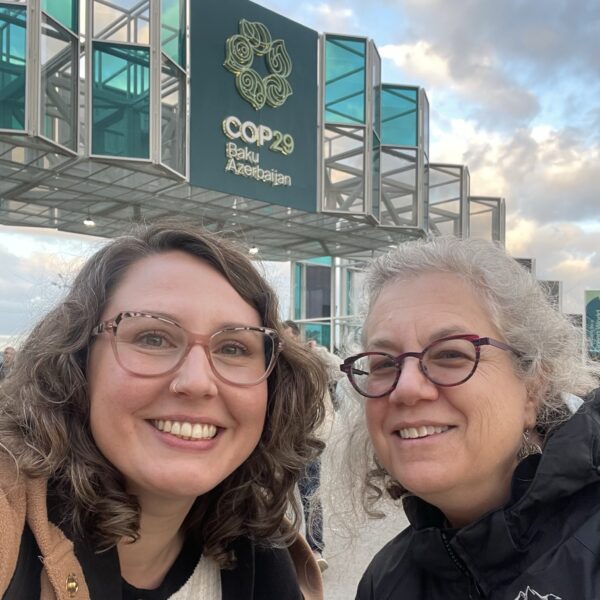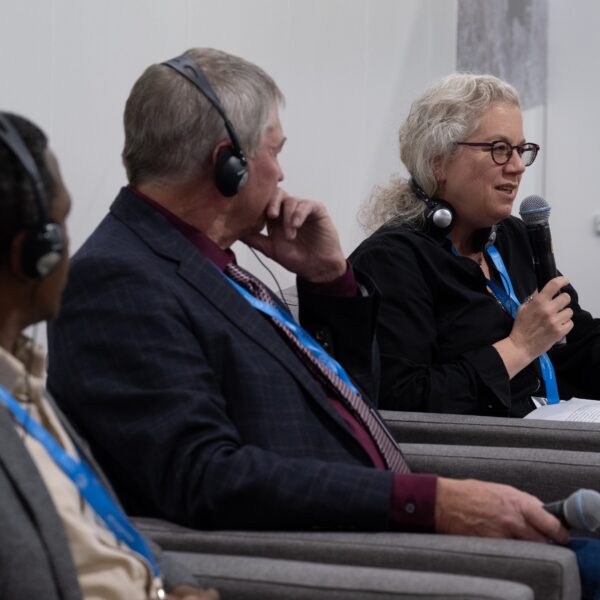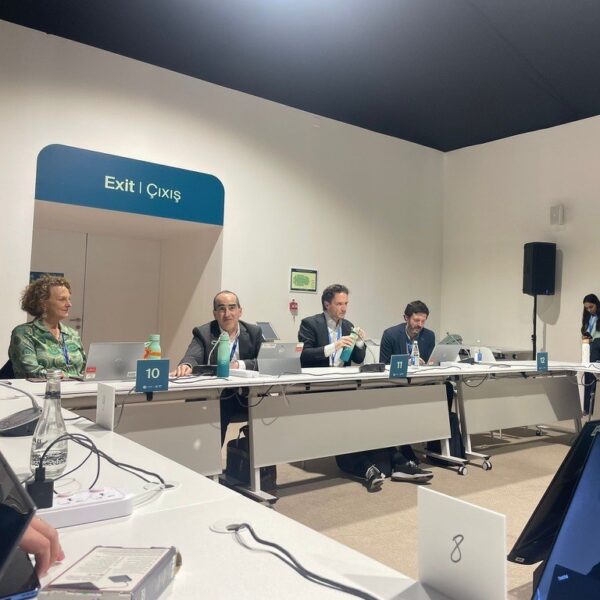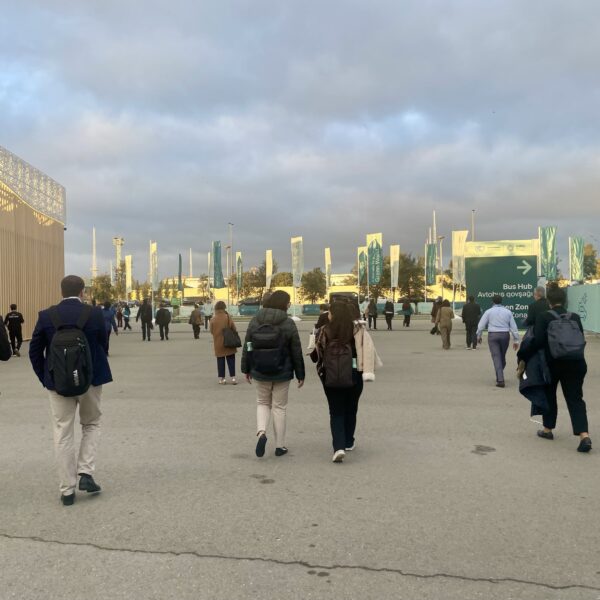In November 2024, SOCODEVI, represented by observers Renée Brunelle, Expert Environnemental Advisor, and Andrée-Anne Côté-St-Laurent, Policy and Advocacy Advisor, attended the 29th Climate COP in Baku, Azerbaijan.
The Conferences of the Parties (COP) are crucial international events where governments, civil society, businesses, and experts coordinate efforts to combat climate change.
Understanding the mechanisms of these conferences can be challenging. Here are five key insights to better grasp such events:

1. Why Attend the COP?
Climate COPs are not exclusively for governments; they also gather civil society, NGOs, lobbyists—including those from fossil fuel industries, who comprised 1,700 of approximately 56,000 participants at COP29—and scientists. This diversity creates a unique dynamic, providing organizations like SOCODEVI a platform to influence global discussions. At COP29, which focused on global climate finance, it was a crucial opportunity to advocate for equitable, inclusive, and gender-sensitive climate financing.
For SOCODEVI, COP29 was an opportunity to highlight cooperative solutions to effectively address climate change challenges, whether in mitigation, adaptation, or recovery after shocks. It also amplified the voices of the most affected communities to Northern countries—including Canada—while strengthening alliances with key partners.
2. What Was SOCODEVI’s Contribution to COP29?
By actively participating in discussions, SOCODEVI generated enthusiasm for the cooperative model, highlighting concrete solutions tailored to local needs.
Here are the four events where SOCODEVI were panelists:
1. Canada’s Climate and Agricultural Leadership: Global and Local Issues
November 19th – Canada Pavilion

Renée Brunelle emphasized the importance of multisectoral approaches to strengthen climate resilience, highlighting the role of cooperatives, access to local financing, and the engagement of women and youth. During the panel organized by the Canadian Foodgrains Bank, which included representatives from the World Food Programme (WFP), the International Fund for Agricultural Development (IFAD), World Vision, and other organizations, she stressed the need for long-term financing, biodiversity preservation, and multi-stakeholder engagement. She also emphasized the importance of structural investments in agriculture, particularly through cooperatives.
2. Sustainable Development at the Climate-Nature Interface: Feeding the World Sustainably
November 19th – Deloitte Pavilion and Canada Pavilion

Alongside Deloitte, Aon, Satelligence, and Global Affairs Canada, Andrée-Anne Côté-St-Laurent participated in two panels (Green Zone and Blue Zone) to encourage the private sector to listen to farmers, notably by inviting them to panels, and to fund existing innovations. She explored the climate-nature interface, food security, and the cooperative model for climate action and resilience.
3. Boosting Community-Level Climate Action: What Arguments Tip the Scale?
November 19th – Organisation internationale de la Francophonie (OIF) Pavilion
In this panel organized by the FAO (in French only), Renée Brunelle showcased SOCODEVI’s Field Schools methodology, successes like the CasaMiel project in Casamance, and provided strategic recommendations for scaling up cooperative solutions.
4. Baku Dialogue on Quebec’s International Cooperation
November 14th

SOCODEVI also actively participated in the Baku Dialogue on Quebec’s international cooperation in the presence of Quebec’s Minister of Environment and Climate Change, Benoît Charrette. On behalf of Quebec civil society, Andrée-Anne addressed the minister multiple times to understand the government’s action plan to ensure continued funding for projects under Quebec’s International Climate Cooperation Program (PCCI) while maintaining the achievement of carbon neutrality in Quebec.
3. How Do COPs Work?
COPs are events that bring together the 197 countries that are parties to the United Nations Framework Convention on Climate Change (UNFCCC). Each COP revolves around negotiations on various themes.
Discussions take place in different spaces:
- Official Zones (Blue Zone): For formal negotiations between countries.
- Pavilions (Blue Zone): Showcases for countries and organizations, like Canada’s pavilion where SOCODEVI presented its expertise.
- Civil Society Spaces (Green Zone): Where non-governmental actors contribute to debates and network.
In 2024, there were three COPs: the climate COP (COP29 in Baku), the biodiversity COP (COP16 in Cali, Colombia), and the desertification COP (COP16 in Riyadh, Saudi Arabia).
If you’re not representing a government, you need an observer badge to access the Blue Zone.
A Bit of History: The Roots of COPs
COPs stem from the legacy of the three major conventions adopted at the Earth Summit in Rio in 1992 and ratified by 197 countries (the Parties):
- United Nations Framework Convention on Climate Change (UNFCCC): This convention initiated the COPs, aiming to stabilize greenhouse gas concentrations in the atmosphere and prevent “dangerous” human interference with the climate system. It takes place annually.
- Convention on Biological Diversity (CBD): Aims to preserve the diversity of ecosystems and species. It is held approximately every two years.
- Convention to Combat Desertification (UNCCD): Seeks to mitigate the effects of desertification and support affected communities.
Climate COPs, like COP29, build on this momentum to unite nations around concrete measures and assess progress on climate commitments. Each edition provides an opportunity for Parties to strengthen their Nationally Determined Contributions (NDCs), adopt new regulations or initiatives, and focus on priority areas such as clean energy, climate finance, and adaptation to climate impacts. The annual meetings also serve as a platform to address implementation challenges and accountability, while mobilizing international cooperation.
4. Are COPs Criticized?

Despite their significant role in rallying countries, COPs often face criticism for their slow pace and inability to produce binding results. Former UN Secretary-General Ban Ki-moon recently called for COP reforms to make them more effective and inclusive.
Key criticisms include:
- Presence of Fossil Fuel Lobbyists: Seen as a barrier to progress.
- Lack of Representation from Southern Countries: Despite being the most affected by climate change.
- Slow Processes: Incompatible with the urgency of the climate crisis.
The agreement on climate finance reached at COP29 sparked significant disappointment among participants, including SOCODEVI, as expressed in a press release (in French only) by the Quebec Association of International Cooperation Organizations (AQOCI). The debate over the balance between grants and loans heightened the sense that the proposed solutions were insufficient and unfair.
“The new climate finance target (NOCQ), set at $300 billion USD by 2035, is far below the needs of the global South, which are estimated at a minimum of $1.3 trillion annually. […] Moreover, some countries have undermined the fragile progress made in recent years on gender and phasing out fossil fuels. These trends are worrying for the future.” – AQOCI
The abrupt conclusion of negotiations through a tactic known as “gavelling”—ignoring dissenting voices in the room—left several crucial issues unresolved for Southern countries, which preferred no agreement over a bad one.
A more inclusive and ambitious global mobilization is therefore necessary to address the climate emergency. Based on this, Canada faced a wave of criticism in December for its new climate target (Nationally Determined Contributions), which aims to reduce greenhouse gas emissions by 45–50% by 2035 compared to 2005 levels.